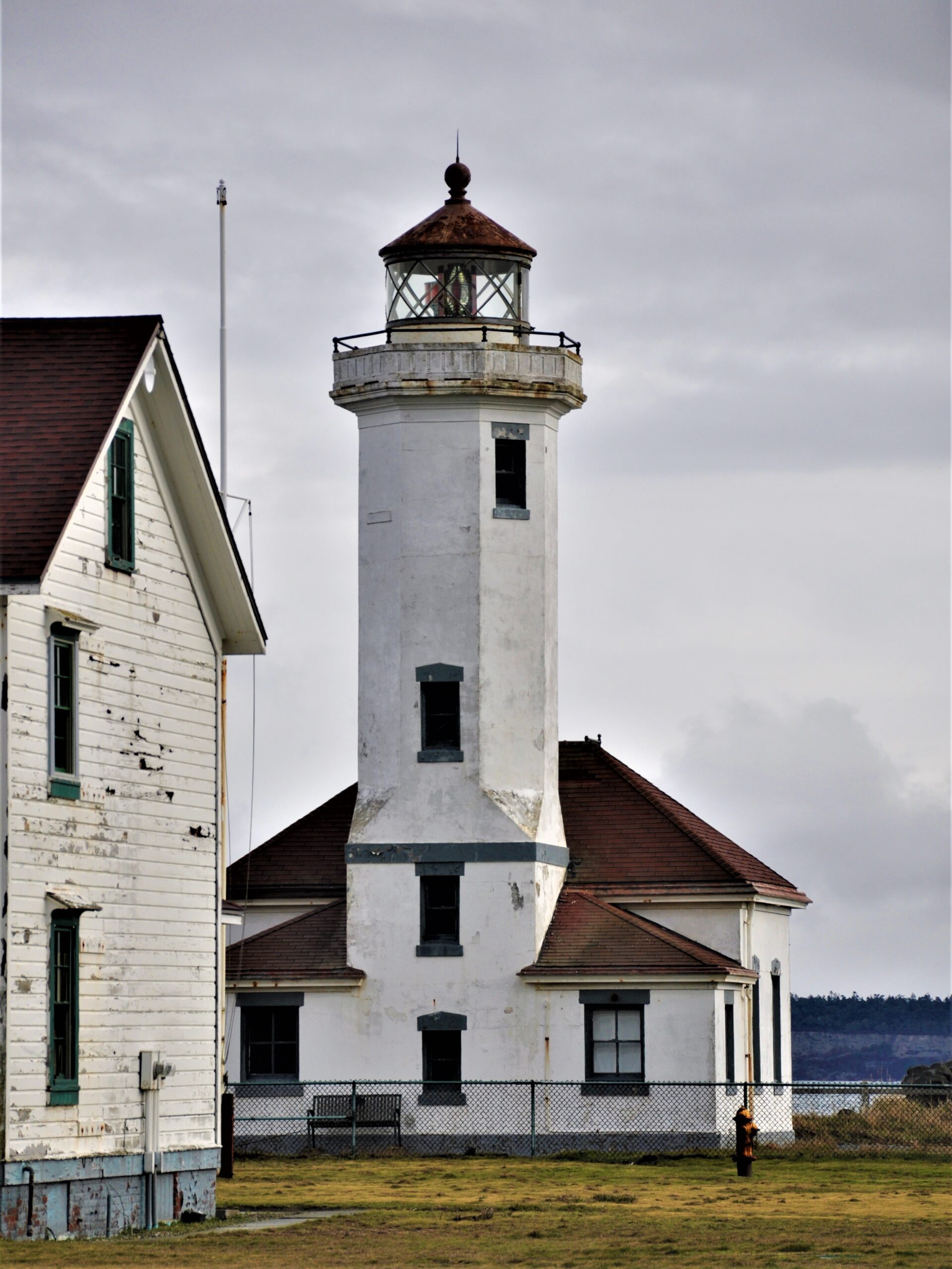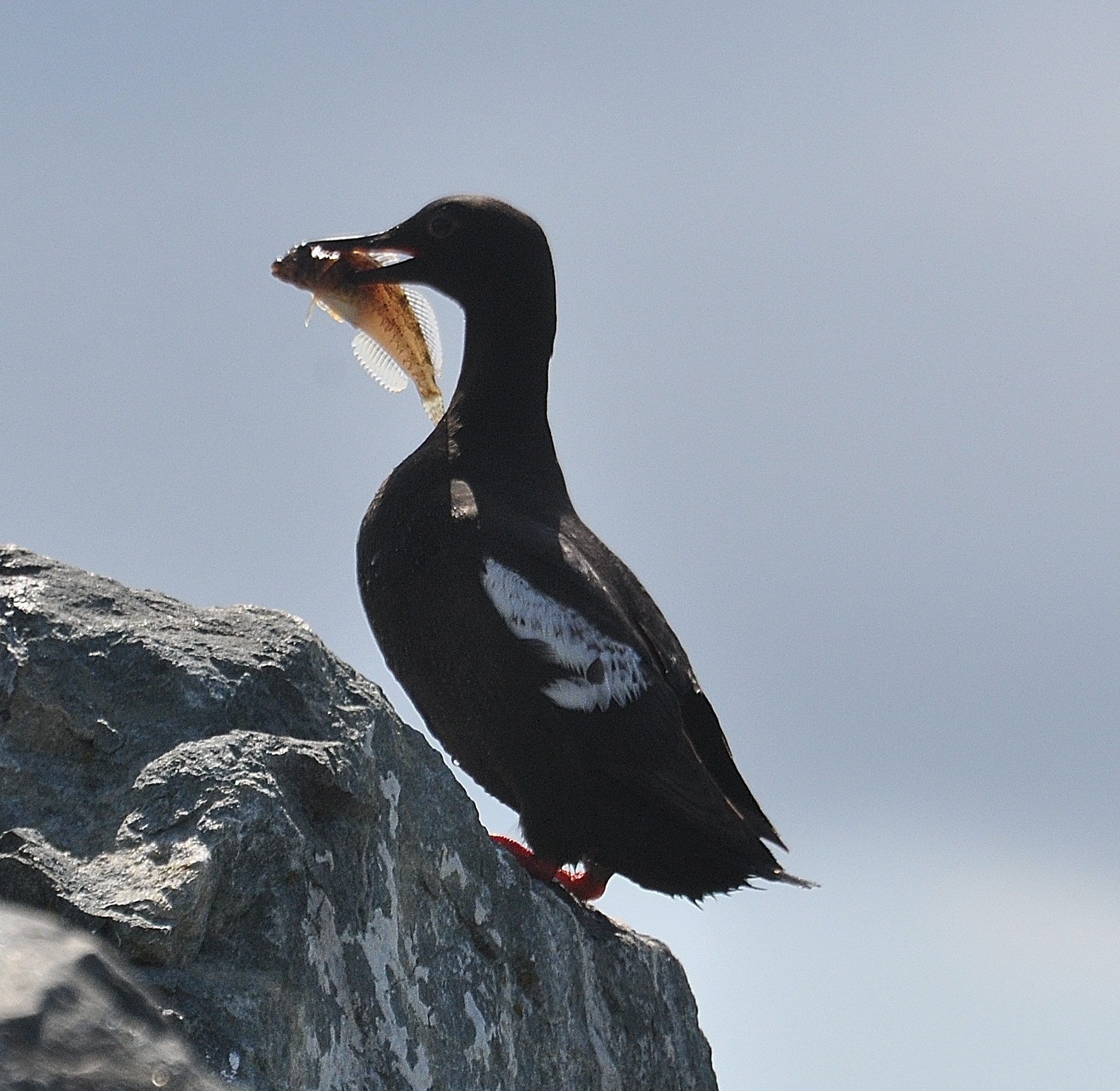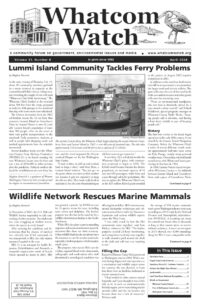Beaks and Bills
by Joe Meche

photo: Joe Meche
Point Wilson Lighthouse
The big getaway to celebrate our 28th Anniversary was all set, reservations were made and we were packed and ready to roll … and along came the weather! I awoke with a start at 3:30 in the morning, and, after checking the weather on the coast, I leaped into action! In no time at all, the original reservations were cancelled and new ones were made … instead of Tokeland and Ocean Shores we headed to Port Townsend (PT), with a sigh of relief. We saw no point in making a five-hour drive through the infamous EST (Everett-Seattle-Tacoma) corridor to be driven indoors for three days by the rain and strong winds on the lower coast. Sometimes we make wise decisions.
In reality, it turned out to be a very easy transition, given that PT and the surrounding area are quite familiar to us. We not only knew where to find birds, but also knew about the best places to eat, along with the location of one of the best bookstores on Puget Sound. In case you’re a book lover like me, it’s the William James Bookseller on Water Street, the aptly named main street in PT.
Point Hudson is on the northern edge of downtown PT and boasts a small RV campground and a gravel spit that always attracts a variety of birds. In the past, I’ve seen dunlin, black-bellied plovers, western sandpipers, and even a whimbrel on the rocky shoreline. On this trip, the expected Pacific black brant and black oystercatchers were joined by three species of gulls and the usual accompaniment of crows. It’s a great spot to set up a scope and glass the waters of Admiralty Inlet for seabirds like common murres and rhinoceros auklets.
The lighthouse at Point Wilson is an easy drive from downtown through lovely tree-lined streets leading up to and through the grounds of Fort Worden. The lighthouse is perfectly situated at the main entrance to Admiralty Inlet and provides one of the best locations in the area to search for and observe a diverse variety of seabirds … much the same as Point Hudson, but with an even wider view into the Strait of Juan de Fuca.
A big part of the history of this part of Washington involves three long-defunct military installations. In the late 1800s, three forts with large guns were built around Admiralty Inlet, the entrance to Puget Sound. Fort Casey was built on Whidbey Island; Fort Worden was directly across the inlet northwest of PT; and Fort Flagler was built on Marrowstone Island to the south. The three forts were strategically placed as a Triangle of Fire to thwart any invasion by sea. After the establishment of the Puget Sound Naval Shipyard in Bremerton in 1891, there was suddenly a valuable military installation to protect. Three additional forts were built in other strategic locations with a similar goal in mind. Plan ahead and be prepared!
The invasion(s) never came, and, though the forts were used for training purposes during both World Wars I and II and the Korean War, they were eventually decommissioned and dismantled. In an amazing process to preserve the history of the forts and open the land for public use, the forts and the land they occupied were purchased by the Washington State Parks and Recreation Commission. Over time, they evolved into three of Washington’s finest state parks. The largest of the three, Fort Worden, now houses a large conference center and the Puget Sound Coast Artillery Museum and a balloon hangar that was used for airships. All of these forts have been placed on the National Register of Historic Places.
If you spend a few days at PT as we often have, all three of these forts are well within range for exploration and offer some of the best bird-watching venues in the state. Our first stop on our getaway was at Point Wilson, on the north end of the grounds of Fort Worden. The old lighthouse, the Point Wilson Light, is still in use as one of the most important navigational aids in the state. No longer are there keepers of the light, however, since it is fully automated now. The light itself is operated by the U.S. Coast Guard, while the grounds are managed by Washington State Parks. Two miles of beaches at this scenic point are open for public recreation and sunsets on the Strait of Juan de Fuca are frequently stunning.
Fort Flagler, another arm of the Triangle of Fire, is at the tip of Marrowstone Island and is now a Washington State Park Recreation Area. This park has expansive views of Mount Baker in the North Cascades, the Olympic Mountains, and Admiralty Inlet and offers hiking, biking, camping, and water sports. Many of the old buildings have been preserved and even renovated to accommodate visitors and provide spaces for multiple cultural and athletic events. The shoreline is great for water birds and I’ve heard great horned owls calling in the surrounding woods.
We have visited the last of the three forts, Fort Casey, numerous times over the past three decades. We’ve actually camped at the state park campground that abuts the Washington State Ferry landing at Keystone on Whidbey Island. From the campground, you can wander to your heart’s content up and over the ridge to the old artillery installation and the grounds around Fort Casey State Park. This is the highest of the three forts and the views are beyond magnificent. From this promontory you can feel the potential of the three installations to guard the entrance to Puget Sound.
Across the highway from the ferry landing and adjacent to the state park is the Crocket Lake Wetland Preserve, which is being enhanced and restored by the Whidbey Camano Land Trust. When you speak to bird-watchers in Washington state about good places for birds, the conversation often leads to Crockett Lake. American white pelicans frequently stop by the lake during migration and put on quite a show. My estimate of a stopover flock a couple of years ago was at least 200 individuals. Raptors like bald eagles, red-tailed hawks, northern harriers, and short-eared owls are frequent sightings there and just across the road on the beachfront.

photo: Joe Meche
Pigeon guillemot
In all the times that I’ve had occasion to visit the Keystone landing, my favorite birds have been the pigeon guillemots. These birds are the mascots of the Whidbey Island Audubon Society and are one of the most entertaining species you’ll ever encounter. Their behavior is complemented by their bright orange bills and matching feet. The lining of their mouths is the same color and contrasts well with their dark plumage. Bird-watching is rarely as fun as it is with an active, feeding flock of pigeon guillemots.
In all, our backup plan worked out just fine and we came home more relaxed than we would have been after dealing with I-5 traffic for five hours in both directions. We ended our getaway with a stop in Coupeville, another favorite waterside community on Penn Cove and the second-oldest town in Washington state. We’ve been to this delightful waterfront numerous times and had to make one last stop before heading home, at Kapaw’s Iskreme … one for the road, you might say!
__________________________________________
Joe Meche is a past president of the North Cascades Audubon Society and was a member of the board of directors for 20 years. He has been watching birds for more than 60 years and photographing birds and landscapes for more than 40 years. He has written over 200 columns for Whatcom Watch.




























